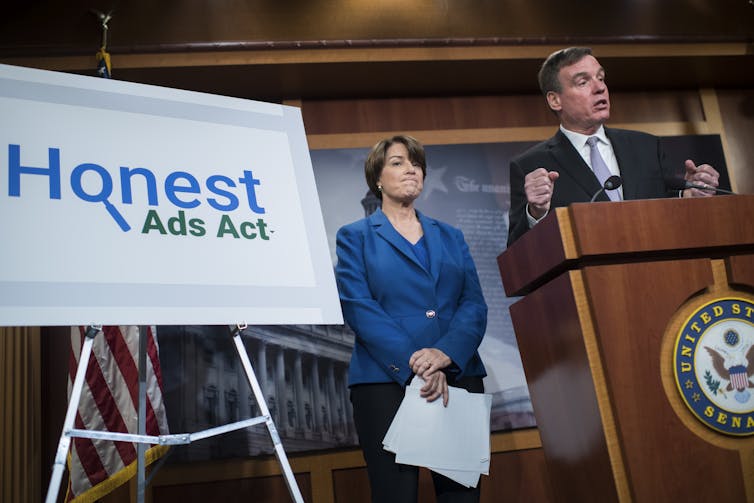Think back to the last time you scrolled through your social media feed and encountered a political ad that perfectly aligned with your views – or perhaps one that outraged you. Could you tell if it was from a legitimate campaign, a shadowy political action committee or even a foreign entity? Could you discern who paid for the ad? Chances are you couldn’t.
While television and radio political ads have been subject to strict disclosure requirements for decades, their online counterparts exist in a regulatory vacuum. Social media giants like Facebook, X – formerly Twitter – and Instagram have become central battlegrounds for political campaigns. Yet they operate without the transparency mandated for traditional broadcast media. This allows advertisers to use sophisticated microtargeting to tailor messages to voters, often exploiting detailed personal data.
Welcome to the unregulated Wild West of online political advertising, where transparency is scarce and accountability is lacking. With the 2024 U.S. presidential election in full swing, this digital frontier poses an unprecedented threat to the integrity of American democracy.
The good old days
The McCain-Feingold Act became law over two decades ago. The law, officially known as the Bipartisan Campaign Reform Act of 2002, was designed to curb the influence of money in politics and increase transparency in campaign financing. The landmark legislation, championed by Senators John McCain (R-Ariz.) and Russ Feingold (D-Wis.), includes the regulation of issue advocacy ads on television and radio.
The McCain-Feingold Act addressed the need for disclaimers and the “Stand by Your Ad” provision, which required candidates to personally endorse their messages in TV and radio ads. Such regulations have proved effective in maintaining a level of accountability and transparency in traditional media.
The media landscape has undergone a dramatic transformation since the bill’s passage, however. As a communications scholar who studies online advertising, I see the lack of similar regulatory measures governing online political advertisements as a glaring absence. This vacuum leaves platforms responsible for providing transparency.
At the same time, Federal Election Commission rules governing disclosure on digital political ads remain murky at best. The lack of clarity makes tracking and analyzing digital political ads a daunting task for researchers, journalists and concerned citizens.
Ad transparency studies
A recent study conducted by open internet advocacy organization Mozilla and Finnish internet research firm Check First reveals significant deficiencies in the ad transparency tools provided by major tech platforms. Ad transparency tools are collections and analysis of ads that the social media companies make publicly available. Researchers, policymakers and advocacy groups use the tools to understand ads and their effects. The deficiencies raise concerns about the potential for manipulation and deception in the lead-up to the presidential election.
The study examined the ad transparency tools of 11 major tech platforms, including X, Apple’s App Store, Google, Meta, TikTok and LinkedIn. The study found that these tools often provide incomplete data, have broken search functions and are difficult to use effectively. Among the tech giants the study evaluated, X emerged as the worst performer, with a dismal record of providing meaningful data for watchdogs and users alike.
Notably, the study focused on the efforts of these platforms to comply with the European Union’s Digital Services Act, which mandates a certain level of ad transparency. The United States, however, has no comparable requirements, leaving voters vulnerable to potential manipulation and disinformation campaigns.
A study of Meta’s ad policy enforcement found that the company missed most of the political ads on Facebook that had failed to properly identify themselves as political.
Recent academic research offers some insights into the potential effectiveness of political ad labeling. One study tested various transparency information disclosures based on enacted regulations, including the EU’s Digital Services Act, and proposed regulations, including the U.S. Honest Ads Act.
The Digital Services Act is a broad set of regulations that requires online platforms to provide real-time information about which posts are ads and who produced and financed them. The U.S. bill aims to require platforms to maintain publicly accessible records of any political ads purchased by a person or group who spends more than $500 on ads in a calendar year. It also seeks to ensure that foreign entities are not purchasing political ads to influence U.S. elections.
The researchers found that transparency measures based on these regulations were most effective in increasing users’ ability to recognize and understand persuasion attempts in advertising. However, the academic study also highlighted significant challenges in implementing ad labeling. Only 30% of participants remembered noticing the transparency information, underscoring the difficulty of making such measures effective in the fast-paced world of social media.
The stakes
The importance of ad transparency was spotlighted by a recent report from AI Forensics, a European nonprofit that investigates influential and opaque algorithms. The report, titled “No Embargo in Sight: Meta Lets Pro-Russia Propaganda Ads Flood the EU,” revealed that a massive network of pro-Russian propaganda targeted voters in France and Germany. It reached 38 million user accounts in just six months. Meta failed to identify and label the vast majority of these ads as political in a timely manner, allowing the disinformation to spread rapidly.
Experts are increasingly concerned about the potential for similar disinformation campaigns to target American voters. With wars raging in multiple global hot spots and platforms like X and Facebook struggling to monitor and report on political ads effectively, the risks of electoral interference and voter manipulation are significant.

Tom Williams/CQ Roll Call via Getty Images
Despite the Honest Ads Act’s high-profile bipartisan sponsors and the potential effectiveness suggested by academic research, most analysts predict that partisan gridlock and tech industry lobbying will keep the legislation from being passed before the November 2024 election. This lack of legislative action leaves the U.S. without robust ad transparency tools, making it difficult for the public to identify the sources behind political ads on digital platforms.
Advocates have called on tech platforms to prioritize the development of more robust and user-friendly ad transparency tools ahead of the election. They argue that without meaningful reforms, the integrity of the democratic process is at risk, leaving voters vulnerable to manipulation and deception.![]()
This article is republished from The Conversation under a Creative Commons license. Read the original article.
Steven Caplan, Adjunct Instructor of Communications and Marketing, USC Annenberg School for Communication and Journalism.
Photo by Jose Francisco Fernandez Saura via Pexels.

